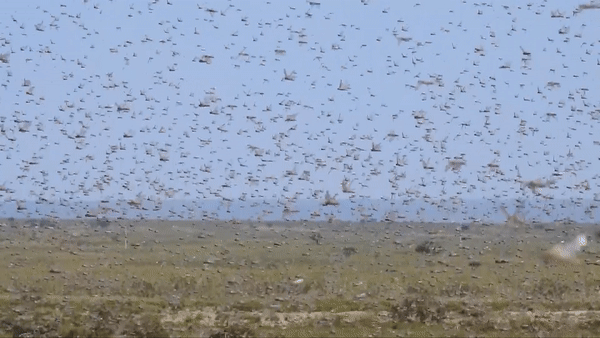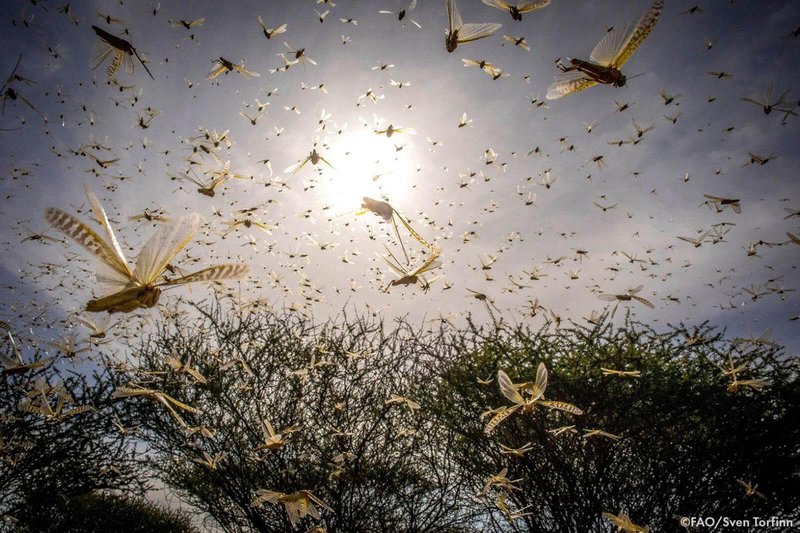Ethiopia: Breeding Ground For the Next Batch of Desert Locust
By Emebet Jigssa, Contributions by Kenneth Kemucie Mwangi and Jasper Mwesigwa


Wind blows, keeping its season driven pattern bringing much needed rainfall. Unfortunately, it also happens to be the major vehicle carrying desert locusts from country to country, crossing borders, oceans and continents.
Since the outbreak in 2019, the Eastern Africa region has fallen under the desert locust threat amidst floods, food insecurity, and other natural and man-made problems yet to unravel. According to the United Nations Food and Agriculture Organization (FAO), Ethiopia and Somalia had not seen such severe desert locust outbreaks in more than 25 years, Uganda in 60 years, and Kenya in 70 years.
Desert locusts hatch in warm moist sand, in semi-arid to arid regions with green vegetation. Which makes Ethiopia favorable for the swarms to breed vastly. In January 2020, the government of Ethiopia reported that desert locusts had infested more than 2,350 km2 of land across the Afar, Amhara, Oromia, Somali, Tigray, and Southern Nations, Nationalities, and Peoples’ (SNNP) regional states, as well as in Dire Dawa city. These areas in Ethiopia are affected by the desert locust invasion and still face further challenges in the time of Covid -19.
If left uncontrolled, the most vicious nomadic pest in the world is about to make Ethiopia home populating and invade all over again.
Rainy season creates favourable breeding conditions in Ethiopia
As per the IGAD Climate Prediction and Applications Center (ICPAC) recently released Desert Locust Movement Prediction alert, the current desert locust invasion areas of Eastern Africa have densified yet again in northern Kenya, and eastern and north-eastern Ethiopia. Scientists have linked the current outbreak to unusually favorable climate and resultant ecological conditions, both in Arabia and Eastern Africa regions — primarily driven by climate change [1]. Sudan and Somalia are also countries the locust swarms are migrating to, but the current weather conditions are not yet as favorable as in Ethiopia to populate. Presently, it is the rainy season (Kiremt) in Ethiopia. Most of the land being blessed with heavy rain (that started earlier in June) favouring the planted crops and unplanted vegetation. The rainy season runs through June to mid September.
The ongoing heavy rainfall is predicted to create favourable breeding conditions for the locust in Ethiopia, which calls for coordinated efforts to combat the pest from doing irreversible harm and spreading to other countries in the region. Additionally, the COVID-19 pandemic has not only been infecting and taking lives, but has occasioned stringent mitigating measures, including closure of borders and air transportation restriction. Making it difficult to import, distribute and spray pesticide to protect farms.
If not controlled on time, a country that is already food insecure will add millions more to those needing food assistance. Most Ethiopians still rely on agriculture and locusts are destroying this source of livelihood with pastoralists also having localized impacts.
Urgent regional coordinated response needed
The Ethiopian Federal Ministry of Agriculture and the Desert Locust Control Organization for Eastern Africa, including FAO have been working together to control the locust infestation since the pests started invading the country. The previous invasions already caused a significant decrease in agricultural production which will create food shortages. A joint impact assessment report released in April indicates that an estimated 1 million people will need food assistance due to the impacts of the desert locust in 2020, having lost close to 200,000 hectares of cereal crops equivalent to over 3.5 million metric tonnes of grain.
Kenya fortunately has managed to considerably control the situation by intensified efforts on locust control and nature’s help (the wind direction changed). The country has minimized the damage through controlling the spread of the locust to different counties bringing it down to only three in the north and north-west. However, the locust’s silent growing armies are not far away, they can come back with the expected annual changes in wind direction from Ethiopia or neighboring Somalia which calls for continued surveillance and monitoring.
Countries in the region should put their resources together and employ greater coordinated effort to win the battle against the desert locust and protect their lands, neighbours land, and minimize the damage or avoid it if possible.
As per FAO updates in early 2020, aerial and ground control operations have been ongoing since July 2019. However, the locusts are not easy to control due to its speedy reproduction rate and the continuous formation and migration of new swarms. This situation will make control efforts in Ethiopia very challenging since the rainy season will make the land a reproduction and development heaven for the desert locust to continue to multiply. Luckily, due to intense surveillance and the use of satellite and geo-information technologies, locust breeding areas are known near real-time and control efforts can be smarter.
